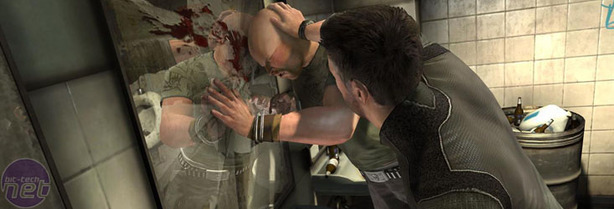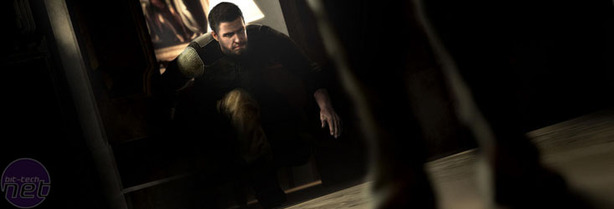
Fisher for Compliments
Gameplay-wise, Conviction feels pretty similar to the older Splinter Cell games and, despite the fact that the gadgets and guns at Fisher’s disposal have seen another batch of enhancements, the game retains the focus on being stealthy.In Fisher’s world you can only really be invincible if you’re invisible, so staying in the shadows is always a must – especially when the enemy can track you better than ever before using the Last Known Position mechanic. Luckily, like all good assassin-spies, Fisher can fairly easily turn this new feature around on his foes.
The premise behind Last Known Position is fairly simple; that the enemy will investigate or attack where they think you are, so if there are three guards in a room and you pop out from behind a barrel and headshot one of them then the other two will know where you are. They’ll lay down covering fire and then one of them will probably try and flank you while the other keeps watch – something the guards did to us several times.
So far, so samey then – but with Last Known Position you can easily see where the enemy thinks you are via a ghostly silhouette of the AI’s best guess. Then you can get the hell out of there and turn the flank back on them. If you know they think you’re somewhere you aren’t then you can move to a better position to take them down, or know they’ll lose you completely when their search turns up zilch.
Nor is flanking or fleeing your only option either, as Fisher’s range of aggressive acrobatics and stealth kills has been expanded once more. You can hang from pipes, snap necks, melee kill, take hostages and make use of the Mark & Execute mechanic, which lets you mark targets at a distance and then unleash a quick execution on all of them within range. You’ll need to power it up by doing hand-to-hand kills however, which is a slightly uncharacteristic break from the mesh between the story and feature-set.
On the plus side, the melee battles in Splinter Cell: Conviction are far better than any we’ve seen in the series yet and even go so far as to include some Bauer-esque torture sequences where you can choose to bounce a bad-guy's head off nearby items. It’s a little bit unusual and worrying for us to admit this, but we took a huge amount of pleasure from choosing how to extract information from an unwilling commander – though we do get the feeling that Conviction will overuse the idea. Still, stabbing someone through the hand is always fun, no matter how many times you do it. [First job on Monday morning is hiding all the sharp knives in the office then? - Ed]
Just because you have all these new melee attacks and super-attacks doesn’t mean you have to rely on them all the time though – our favourite part of our time with Splinter Cell: Conviction was when we got to play with the gadgets, not the guns. Sam’s signature goggles let him track and mark opponents through walls, while his cool remote cameras can be used to monitor enemies secretly or play sounds to attract attention. Sam’s not above turning the enemy’s weapons against them either, and carries a small EMP weapon of his own to deactivate nearby lights and machines.
What really struck us about Splinter Cell: Conviction wasn’t the new gadgets or the new moves (which, away from the main new features, are mostly pretty iterative). It was the enhanced sense of drama and theatre that had been infused into the game, with the new illuminated memories and objectives feeling very reminiscent of 24’s split screen tactics and making Sam more of a beleaguered and gruff hero than ever. At the same time, it makes Conviction as a whole a much more interesting and engrossing piece of design and fiction than we’ve previously seen from Splinter Cell. We can’t wait to see more.
Splinter Cell: Conviction is published by Ubisoft and is due for release on the 26th February 2010 for the Xbox 360 and PC. Until then, let us know your thoughts about the game in the forums.

MSI MPG Velox 100R Chassis Review
October 14 2021 | 15:04











Want to comment? Please log in.